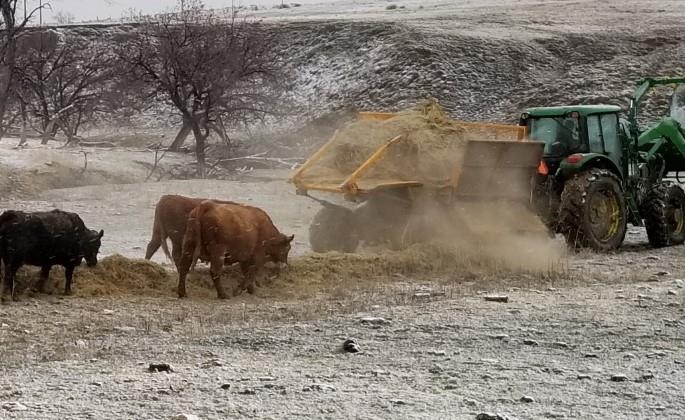Many livestock operations harvested drought-affected crops, annual small-grains or other alternative forages to make up for reduced hay production in North Dakota. These drought-stressed forages can be high in nitrates and cause toxicity issues in cattle, say North Dakota State University (NDSU) Extension specialists.

Drought-stressed forages can be high in nitrates and cause toxicity issues in cattle. (NDSU photo)
Small-grain annual forages such as wheat, barley and oats, as well as brassicas, millet, sorghum, sudangrass, and standing corn can contain toxic levels of nitrates.
Nitrate toxicity is most commonly a problem in ruminants, with cattle more susceptible than sheep. Dietary concentrations above 1,000 parts per million (ppm) of NO3-N (nitrate-nitrogen) or 7,220 ppm of KNO3 (potassium nitrate), depending on the laboratory analysis performed, can result in nitrate poisoning.
Given the extent of the drought this year, all forages should be tested for nitrate content.
“Once nitrate levels are known, grinding and blending low- and high-nitrate hay is the best strategy to reduce risk,” says Zac Carlson, NDSU Extension beef cattle specialist. “If producers cannot grind and blend hay, unroll low-nitrate hay first, wait for cattle to consume most of the low-nitrate hay and then unroll the high-nitrate hay. In addition, providing a couple of pounds of grain per animal daily can help reduce the risk of nitrate toxicity.”
“Slowing down the intake of high-nitrate hay is key to reducing risk,” says Janna Block, Extension livestock systems specialist at the NDSU Hettinger Research Extension Center. “Always be sure animals are not hungry before introducing high-nitrate forages.”
Carlson notes, “Be sure high-nitrate hay is not damp before feeding. Excess moisture can result in some nitrate converting to the more toxic form, nitrite.”
Cattle can adapt to higher levels of nitrates by slowly transitioning from low nitrate to higher nitrate forages. Research indicates that properly-adapted cattle can consume diets containing approximately 2,000 ppm of NO3-N or 14,440 ppm of KNO3.
Ensiling high-nitrate forages will help reduce the nitrate concentration up to 50%. To effectively reduce nitrates, proper ensiling must occur, which requires approximately 21 days. Be sure to test the silage for nitrate content before feeding.
“Clinical signs of nitrate poisoning are related to lack of oxygen in the blood,” says Gerald Stokka, NDSU Extension veterinarian and livestock stewardship specialist. “Several hours after consuming toxic levels of nitrates, cattle will display difficult and rapid breathing, a darker brown color change of the mucous membranes, and weakness, tremors and staggering.”
Pregnant females that survive nitrate poisoning may lose their calf due to lack of oxygen in their blood. This can happen approximately 5 to 14 days following exposure to high nitrates.
Producers with high-nitrate forages needing assistance with developing a management plan can contact their local NDSU Extension agent and check out the NDSU Extension publication “Nitrate Poisoning of Livestock” at https://www.ag.ndsu.edu/publications/livestock/nitrate-poisoning-of-livestock.
Source : ndsu.edu